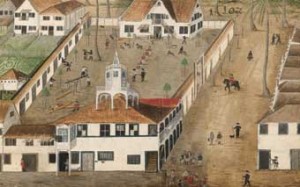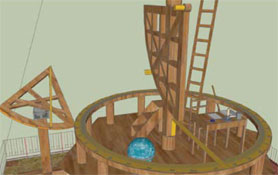
STATE ART COLLECTION DRESDENThe residence of His Excellency: a watercolor by Zacharias Wagner showing the mansion with the observatorySTATE ART COLLECTION DRESDEN
At the time when the German count Maurice of Nassau was ruling over Recife and a goodly part of the Northeast of Brazil (1637-1644), then a Dutch territory, artists and naturalists came to Brazil for a while, to describe landscapes and animals, draw maps, find out about the territory and prospect riches. The best known are the painters Frans Post, Albert Eckhout and Zacharias Wagner, the physician Wilhelm Piso, and George Marcgrave, a German. The latter was probably the first naturalist and astronomer to write descriptions and conduct scientific studies in Brazil with a more modern view, by giving due value, with his method, to observation and experimentation. The 400th anniversary of his birth falls in 2010 and this year the book O observatório no telhado [The rooftop observatory], (Companhia Editora de Pernambuco publishing house), by the astronomer Oscar T. Matsuura, is to be released. It is a detailed study of merely one of Marcgrave’s contributions: his astronomy.
“Marcgrave was a polymath at the dawn of modern science. He wasn’t the classical medieval scientist any more, of the sort that only looked for knowledge in the past”, says Matsuura, a retired professor from the Institute of Astronomy, Geophysics and Atmosphere Sciences of the University of São Paulo, who is currently an associate researcher at the Museum of Astronomy and Related Sciences (Mast) and an associate professor of the Program of History of the Sciences, Techniques and Epistemology of the Federal University of Rio de Janeiro. “Though still in a transition stage, he was different from his predecessors in Brazil; he had been specifically educated and trained to discover new knowledge by careful and systematic observation of nature”.
The earliest reports prepared in the New World and Marcgrave’s work represent different stages of the evolution of science. “The most amateurish descriptions weren’t validated scientifically. This doesn’t mean that they are scientifically worthless, because, yes, they were valuable, but as primary sources of memorial value”, explains the historian Marcos Galindo, coordinator of the Graduate Program in Information Science at the Federal University of Pernambuco.

"O OBSERVATÓRIO NO TELHADO"/OSCAR T. MATSUURA3D image of the Recife observatory, with a quadrant, a sextant, a telescope and a globe"O OBSERVATÓRIO NO TELHADO"/OSCAR T. MATSUURA
Marcgrave left his hometown, Liebstadt, at the age of 17 and wandered through at least 10 European universities, having thus learnt geography, cartography, botany, medicine, mathematics and astronomy, in Germany, France, Poland, Switzerland and Holland. In Holland, he frequented the University of Leiden in 1636 and 1637, where he studied under the astronomer Jacob Golius and used the observatory, the first ever at an academic institution. Marcgrave was one of the first astronomers to use a telescope to observe the sky systematically.
From Leiden, he came to Brazil, probably influenced by Johan de Laet, one of the directors of the West India Company, which sponsored exploratory journeys throughout the world. Along with Piso, he joined Nassau’s group, already in Recife. Having arrived here in 1638, at the age of 28, he conducted expeditions, described and drew animals and plants and met the natives. After his death at the age of 34 in Angola, his writings were published along with Piso’s in Historia naturalis brasiliae. Carl Linnaeus used Marcgrave’s work to produce his earliest classifications.
In Recife, Marcgrave lived in the same mansion as Nassau. “It was on its rooftop that, in 1639, he built the first astronomic observatory in the Americas, where he conducted observations with the best instruments of the time, including a telescope”, explains Matsuura . In his book, the researcher reconstituted with three-dimensional images (left) what this observatory looked like, thanks to original documents found in the archives of the cities of Leiden and of Paris. The model is to be included in a multimedia exhibition at Mast and in the museum’s web portal.
Republish